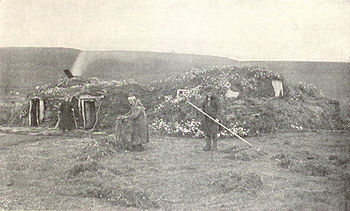
Goahti
Encyclopedia

Sami people
The Sami people, also spelled Sámi, or Saami, are the arctic indigenous people inhabiting Sápmi, which today encompasses parts of far northern Sweden, Norway, Finland, the Kola Peninsula of Russia, and the border area between south and middle Sweden and Norway. The Sámi are Europe’s northernmost...
construction that can be similar to a Sami lavvu
Lavvu
Lavvu is a temporary dwelling used by the Sami people of northern Scandinavia. It has a design similar to a Native American tipi but is less vertical and more stable in high winds. It enables the indigenous cultures of the treeless plains of northern Scandinavia and the high arctic of Eurasia to...
or a peat
Peat
Peat is an accumulation of partially decayed vegetation matter or histosol. Peat forms in wetland bogs, moors, muskegs, pocosins, mires, and peat swamp forests. Peat is harvested as an important source of fuel in certain parts of the world...
covered version using the same base structure. It is often constructed slightly larger than a lavvu. In its tent version the goahti is also called a 'curved pole' lavvu, or a 'bread box' lavvu as the shape is more elongated while the lavvu is in a circular shape.
Construction
The interior construction of the poles is thus: 1) four curved poles (8–12 feet long), 2) one straight center pole (5–8 feet long), and 3) approximately a dozen straight wall-poles (10–15 feet long). Note that all the pole sizes can vary considerably.The four curved poles curve to about a one hundred thirty-five degree angle. Two of these poles have a hole drilled into them at one end, with those ends being joined together by the long center pole that is inserted by the described poles. The other two curved poles are also joined at the other end of the long pole. When this structure is set up, you will have a four-legged stand with the long pole at the top and center of the structure. With the four-legged structure standing up to about five to eight feet in height, approximately ten or twelve straight wall-poles are laid up against the structure. The goahti covering, today made usually of canvas, is laid up against the structure and tied down. There can be more than one covering that covers the structure.
The differences between the goahti and the lavvu can be seen when looking at the top of structures. A lavvu will have its poles coming together, while the goahti will have its poles separate and not coming together.

Birch bark
Birch bark or birchbark is the bark of several Eurasian and North American birch trees of the genus Betula.The strong and water-resistant cardboard-like bark can be easily cut, bent, and sewn, which made it a valuable building, crafting, and writing material, since pre-historic times...
then peat
Peat
Peat is an accumulation of partially decayed vegetation matter or histosol. Peat forms in wetland bogs, moors, muskegs, pocosins, mires, and peat swamp forests. Peat is harvested as an important source of fuel in certain parts of the world...
to provide a durable construction.
Transportation and usability
Traditionally, the Sami transported the whole disassembled structure by having their domesticated reindeerReindeer
The reindeer , also known as the caribou in North America, is a deer from the Arctic and Subarctic, including both resident and migratory populations. While overall widespread and numerous, some of its subspecies are rare and one has already gone extinct.Reindeer vary considerably in color and size...
being used as a pack animal to carry or drag the poles while following their reindeer herd. Today, because of the awkward size of the curved poles, this structure is used less often by the Sami as a transportable shelter. When following their cultural tradition, the Sami more often use the Sami lavvu
Lavvu
Lavvu is a temporary dwelling used by the Sami people of northern Scandinavia. It has a design similar to a Native American tipi but is less vertical and more stable in high winds. It enables the indigenous cultures of the treeless plains of northern Scandinavia and the high arctic of Eurasia to...
for their camping structure.
In the coastal areas the more resident coastal Sami used the peat goahti as a combined human living and livestock building up until the second world war.

